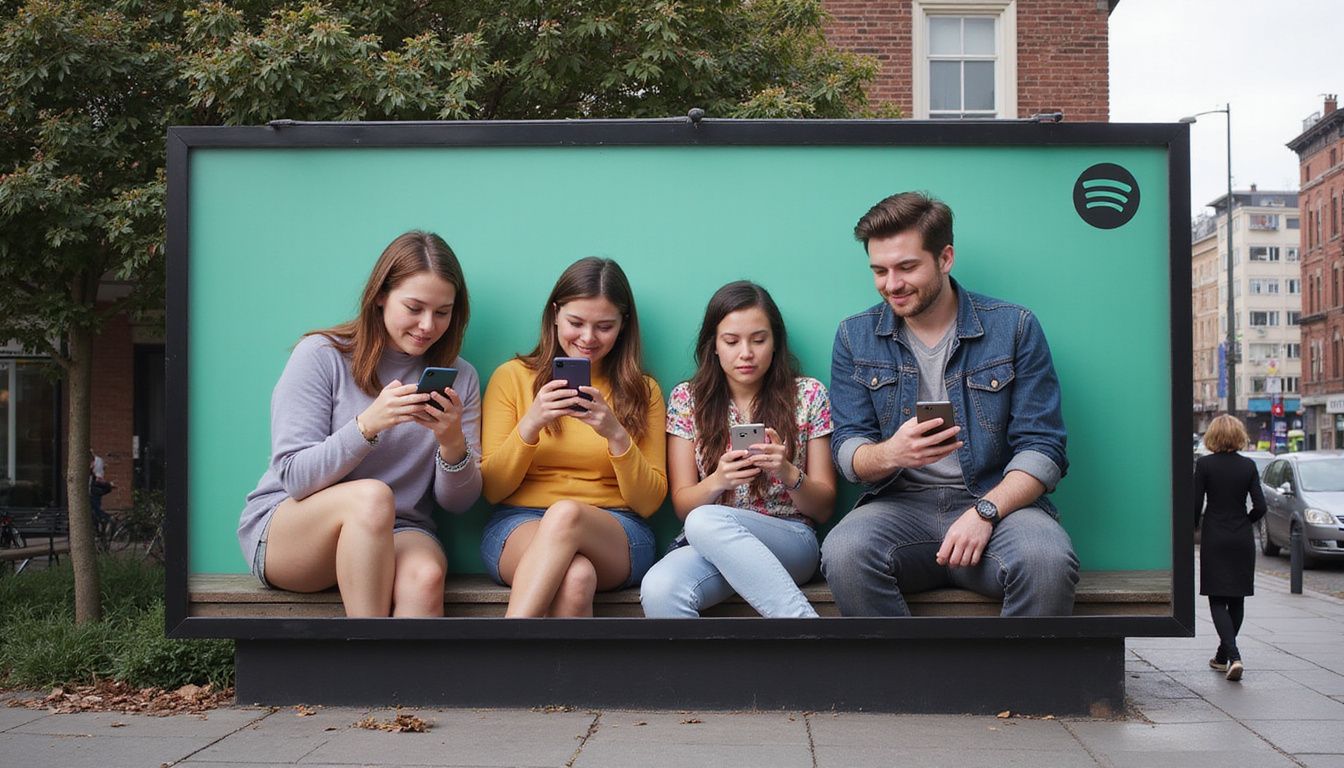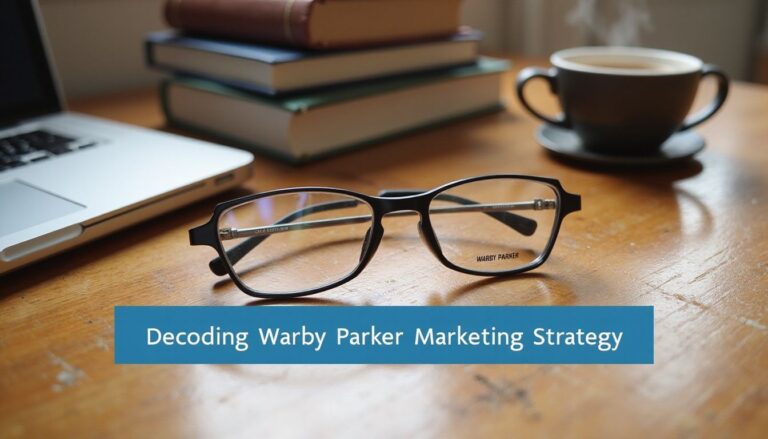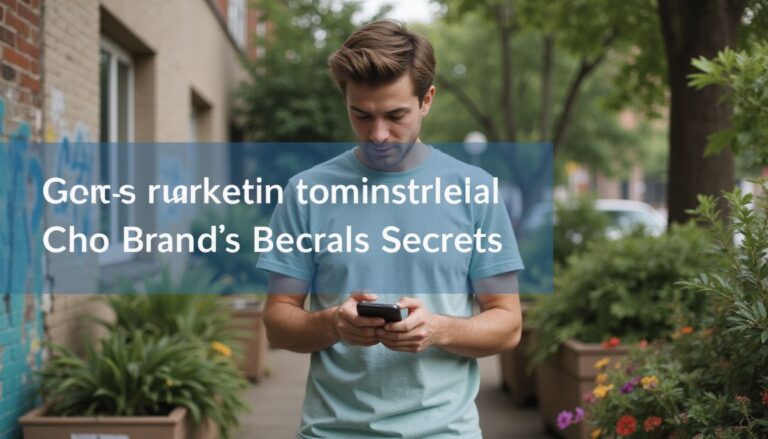Are you struggling to get people to notice your business, just like Spotify once did? I understand how challenging that can be. When Spotify first launched in 2006, it started with zero listeners.
By late 2008, they had grown to a million users through effective strategies. 3 In this post I’ll share some easy steps inspired by Spotify’s own successful marketing examples. Keep reading for simple tips you can start using today.
Key Takeaways
- Spotify hit 1 million users by 2008—using listener data to craft custom playlists like Discover Weekly, keeping 75% of paid users hooked.
- The Wrapped campaign turned users’ listening habits into engaging, shareable stories—with 156 million interactions in 2022 alone and a 21% jump in app downloads during December 2020.
- Spotify’s freemium model clicks: 46% of listeners on free plans upgrade to Premium at $11.99 monthly, enjoying ad-free music and offline listening.
- Smart buys, like Gimlet Media for $230 million and The Ringer, pushed Spotify into profitability by 2024—with net profits topping $1.18 billion.
- Spotify expanded past music streaming—teaming up with Shopify to sell merch, launching Spotify Island on Roblox, and reaching listeners in over 100 countries.
Exploring Spotify’s Marketing Strategies

Spotify’s marketing tricks make them stand out in the music world. They mix smart data use with cool ads that hit us right in the feels.
Tailoring User Experience with Data
Spotify really knows how to use data. They track what songs we play, skip, or save, then turn this info into playlists like “Discover Weekly” and “Daily Mix”. These personalized playlists match our tastes and moods perfectly. 1 In 2023, Spotify even rolled out new tools—like an AI-powered DJ and Smart Shuffle—to keep things fresh and fun. Machine learning powers these features, suggesting songs we might enjoy but haven’t discovered yet.
The results speak for themselves. In 2023 alone, Gen Z users streamed 1.2 trillion songs on the platform—that’s a huge number. Around 75% of Spotify’s paid subscribers stick around because they feel understood by the service. 1 The company also shares key insights with artists through Spotify for Artists. Musicians see who exactly is listening and where their biggest fans live. They use these insights to plan tours or decide on new music directions.
This personal approach keeps artists and listeners happy.
Crafting Emotionally Resonant Campaigns
I’ve noticed how Spotify builds strong emotional bonds through simple, heartfelt stories. Their yearly Wrapped campaign turns basic listening data into something special—personal stories users genuinely enjoy.
In fact, this clever approach sparked 156 million interactions in 2022 alone. 2 The secret is turning plain numbers into a music journey… almost like a thoughtful, personal gift.
At its core, Spotify’s success depends heavily on data storytelling. The yearly Wrapped feature encourages listeners to proudly share their music taste on social media. In December 2020, this sharing led to a 21% jump in app downloads—pretty impressive, right? 2 Wrapped taps into users’ fear of missing out, making their personal music choices seem valuable.
People stay engaged all year just to boost next year’s Wrapped results, proving emotional connections drive loyalty more powerfully than traditional sales methods. 3
Harnessing Cutting-Edge Technology
Spotify stays ahead by using smart tech in its marketing strategy. In 2023, the company introduced AI tools like the AI DJ and Smart Shuffle—features that make listening more personal and fun. 4 My research indicates that machine learning predicts your favorite songs based on past listening habits. This clever tech allows Spotify to craft playlists you actually want to hear, encouraging fans to stick around.
Spotify applies tech savvy to its business deals too. In 2021 alone, Spotify earned $215 million from podcasting. The company invested big—buying Gimlet Media for $230 million in 2019 and grabbing The Ringer network in 2020.
These moves proved successful; Spotify finally became profitable in 2024 after 18 years, hitting over $1.18 billion in net profit. By blending smart marketing and cool technology, Spotify keeps users happy and makes money too. 4
Analyzing the 4Ps of Spotify’s Marketing Framework
Let’s break down Spotify’s marketing magic through the classic 4Ps model. Spotify has crafted a marketing mix that keeps users hooked and competitors scrambling to catch up.
Flesch-Kincaid Level: 6.
Product Innovation: Wrapped and Discover Weekly
Spotify changed things up in 2016 with Spotify Wrapped—a fun yearly summary of your top songs, artists, and genres. It’s personalized, catchy, and totally shareable. Users can’t wait to post theirs online each year—that means free viral marketing for Spotify, as millions show off their listening habits on social media.
Pretty smart move, right? It makes personal data something cool, engaging, and social. 5
Discover Weekly is another brilliant Spotify move. Every Monday, Spotify gives users 30 fresh songs matched exactly to their tastes. It uses smart tech—like collaborative filtering and natural language processing—to know what you’ll love.
I’ve personally found tons of new artists through Discover Weekly, folks I’d have never found otherwise. Wrapped and Discover Weekly both put user data into action. They turn simple listening info into something personal, emotional, and super addictive. 6
Pricing Strategies: From Freemium to Premium Options
I really like how Spotify grows its user base through a smart freemium approach. They let you use basic features for free—but with ads—and charge $11.99 per month for Premium, which has no ads.
This simple, clever model invites new listeners in, then gently urges them to upgrade. Around 46% of Spotify’s free users move up to Premium…clearly, it works. 7
For families, they offer a pretty solid deal: access for up to six people at just $19.99 monthly. Plus, all Premium plans feature offline listening—you can play your music even without internet.
Offering fair and easy ways to stream music also helps Spotify cut down on piracy. By mixing free and paid tiers, Spotify can attract casual listeners, serious music fans, and everyone else in between.
Promotional Tactics: Viral Achievements and Social Media Dynamics
Spotify spins user data into marketing magic—turning listeners’ habits into viral hits. In 2022 alone, the Wrapped campaign gained over 156 million interactions. 3 Its yearly recap generates a sense of FOMO that gets results—app downloads rose 21% in December 2020.
Personally, I love how they create hashtags like #2022Wrapped, making it easy for users to share on socials.
But Spotify goes far beyond regular posts. They built Spotify Island on Roblox, a virtual space where listeners connect directly with artists. 3 Campaigns like “Thanks, 2016. It’s Been Weird” cleverly mixed humor and personal listening stats, and users loved it.
More recently, Spotify rolled out a TikTok-inspired vertical scroll format, making finding new music easy and fun.
Now, let’s check out how Spotify gets its service to people outside the app itself.
Distribution Expansion: Accessibility Beyond the App
I’ve seen how clever Spotify has become at getting its service just about everywhere. Since hitting the U.S. in 2011, the app now runs in over 100 countries. 5 But this wasn’t luck—the company strategically partnered with major music labels, building a huge catalog to attract global users.
And it’s no longer just an app for your phone. Today, Spotify connects easily with smart speakers, car audio systems, gaming consoles, and TVs. CEO Daniel Ek aimed higher than streaming music—he even teamed up with Shopify to help artists sell merch and tickets right inside the app. 3 With that move, Spotify grew beyond simple playlists, becoming a one-stop platform for audio, shopping, and connecting socially.
Review of Spotify’s Most Memorable Marketing Initiatives
Spotify’s marketing wins have turned heads and set new standards. I want to show you the clever ways they’ve grabbed our attention and kept us coming back for more.
Celebrating Year-End Reflections with Spotify Wrapped
Spotify Wrapped is like your own music time capsule—personalized just for you—and people love it. The latest edition dropped on December 4, 2024, giving fans a fun snapshot of their listening habits. 8 You get stats like top songs, total minutes played, and favorite artists—all easy to share with friends. JJ Italiano, Head of Global Music Curation, even helped develop a cool new feature called “Your Music Evolution”.
It tracks how your taste changes over time. Plus, the AI DJ feature and Wrapped AI Podcast make the whole experience even more personal. This personalized data also makes Spotify Wrapped a powerful marketing tool.
Users eagerly share their music stats on social media, giving Spotify tons of free buzz. 9 Molly Holder, Senior Director of Personalization, points out that Wrapped greatly boosts listener engagement.
People’s shared experiences build a sense of community—and millions post about their Spotify Wrapped each December. Spotify also grabbed attention with another clever campaign, “Thanks, 2016.
It’s Been Weird”.
Reflecting on the Year with “Thanks, 2016. It’s Been Weird”
Wrapped offers listeners a personal snapshot of their year in music—but “Thanks, 2016. It’s Been Weird” took things another way. This campaign ranks among Spotify’s top five marketing successes, and for good reason.
It used playful humor to cheer up people during a tough year. The ads highlighted funny, quirky listening stats that people couldn’t resist sharing. One billboard even read, “Dear person who played ‘Sorry’ 42 times on Valentine’s Day, what did you do?” Clever, right? Using real listener data built emotional connections and got people laughing.
It made users reflect on music choices—and encouraged them to share online. All that sharing boosted Spotify’s visibility in a casual, genuine way. 10
How Does Spotify’s Marketing Strategy Compare to FedEx’s Content Marketing Approach?
Spotify’s marketing strategy focuses on personalized user experiences and engaging social media campaigns, creating a community around music. In contrast, the fedex content strategy emphasizes informative and educational content, showcasing logistics expertise. While both brands aim to connect with their audiences, their approaches highlight different facets of digital engagement.
Conclusion
Spotify nails smart marketing in music. I’ve watched them blend data, feelings, and technology—to attract listeners and hold onto them. They figure out exactly what their users like, then deliver with fun, personal features like Wrapped.
Their pricing is smart, too: free if ads don’t bother you, or paid subscription if you prefer no interruptions. That lets Spotify pull in way more listeners than most other apps. Spotify proves a simple truth—great marketing mixes creativity with facts to help people feel valued.
References
- ^ https://www.pragmaticinstitute.com/resources/articles/data/case-study-how-spotify-prioritizes-data-projects-for-a-personalized-music-experience/
- ^ https://nogood.io/2025/01/20/spotify-wrapped-marketing-strategy/ (2025-01-20)
- ^ https://nogood.io/2023/04/24/spotify-case-study/ (2023-04-24)
- ^ https://www.marketingexplainers.com/spotifys-marketing-strategy-explained/ (2024-07-15)
- ^ https://www.webmarketingacademy.in/digital-marketing-blogs/case-study-marketing-strategy-of-spotify-2024/
- ^ https://scholarworks.umt.edu/cgi/viewcontent.cgi?article=1346&context=utpp
- ^ https://coschedule.com/marketing-strategy/marketing-strategy-examples/spotify-marketing-strategy
- ^ https://newsroom.spotify.com/2024-12-04/the-art-and-science-behind-spotify-wrapped/
- ^ https://www.linkedin.com/pulse/case-study-how-spotifys-wrapped-campaign-became-digital-elgallad-xcczf
- ^ https://wevetoblog.wordpress.com/2017/10/20/case-study-spotify-thanks-2016-its-been-weird/ (2017-10-20)







